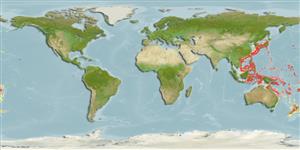Holocephali (Chimären, Seekatzen) (chimaeras) >
Chimaeriformes (Chimaeras) >
Chimaeridae (Shortnose chimaeras or ratfishes)
Etymology: Chimaera: Named for the mythological creature composed of parts of multiple animals, referring to their odd mix of characteristics. (See ETYFish); phantasma: Greek for phantom or apparition, probably referring to its striking appearance in life (silvery, with jet-black bands down the sides) and/or overall ghoulish appearance common to all chimaeras. (See ETYFish).
More on authors: Jordan & Snyder.
Environment: milieu / climate zone / depth range / distribution range
Ökologie
seewasser bathydemersal; tiefenbereich 90 - 540 m (Ref. 9904). Deep-water
Western Pacific: Japan, Korea, China, Taiwan, and the Philippines.
Size / Gewicht / Alter
Maturity: Lm ? range ? - ? cm
Max length : 100.0 cm TL Männchen/unbestimmt; (Ref. 637); common length : 60.0 cm TL Männchen/unbestimmt; (Ref. 9137)
Found in continental shelves and upper slopes (Ref. 9904, 11230); shelf edge, 60-550 m (Ref. 11230). Feeds mainly on small benthic animals (Ref. 637). Oviparous (Ref. 205). Eggs are encased in horny shells (Ref. 205). Used in Chinese medicine (Ref. 12166). Caught with bottom trawls but utilization uncertain except as fish balls (kamaboko) in Japan (Ref. 9904).
Life cycle and mating behavior
Geschlechtsreife | Fortpflanzung | Ablaichen | Eier | Fecundity | Larven
De la Paz, R.M. and R. Interior, 1979. Deep-sea fishes off Lubang Island, Philippines. Nat. Applied Sci. Bull. 31(3-4):175 p. (Ref. 5282)
IUCN Rote Liste Status (Ref. 130435)
Bedrohung für Menschen
Harmless
Nutzung durch Menschen
Fischereien: kommerziell
Mehr Information
ReferenzenAquakulturAquakultur ProfilZuchtlinienGenetikElectrophoresesVererbbarkeitKrankheitenVerarbeitungNutrientsMass conversion
PartnerBilderStamps, Coins Misc.LauteCiguateraGeschwindigkeitSchwimmstilKiemenoberflächeOtolithsGehirngrößeSehfähigkeit
Tools
Zusatzinformationen
Download XML
Internet Quellen
Estimates based on models
Preferred temperature (Ref.
123201): 8.4 - 21.7, mean 15.9 °C (based on 203 cells).
Phylogenetic diversity index (Ref.
82804): PD
50 = 0.5000 [Uniqueness, from 0.5 = low to 2.0 = high].
Bayesian length-weight: a=0.00282 (0.00118 - 0.00673), b=3.10 (2.89 - 3.31), in cm total length, based on LWR estimates for this (Sub)family-body shape (Ref.
93245).
Trophic level (Ref.
69278): 3.5 ±0.42 se; based on food items.
Widerstandsfähigkeit (Ref.
120179): niedrig, Verdopplung der Population dauert 4,5 - 14 Jahre. (Assuming Fec <100).
Fishing Vulnerability (Ref.
59153): High vulnerability (60 of 100).
